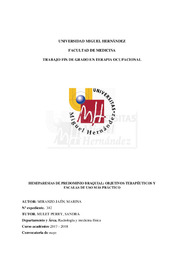Por favor, use este identificador para citar o enlazar este ítem:
https://hdl.handle.net/11000/26178Registro completo de metadatos
| Campo DC | Valor | Lengua/Idioma |
|---|---|---|
| dc.contributor.advisor | Mulet Perry, Sandra | - |
| dc.contributor.author | Miranzo Jaén, Marina | - |
| dc.contributor.other | Departamentos de la UMH::Patología y Cirugía | es_ES |
| dc.date.accessioned | 2022-03-10T15:17:40Z | - |
| dc.date.available | 2022-03-10T15:17:40Z | - |
| dc.date.created | 2018-05-08 | - |
| dc.identifier.uri | http://hdl.handle.net/11000/26178 | - |
| dc.description.abstract | Introducción. Este trabajo pretende abordar desde el punto de vista de la Terapia Ocupacional, la importancia que tiene la funcionalidad del miembro superior en la vida diaria de las personas y su calidad de vida, por tanto la evaluación con escalas estandarizadas y válidas es esencial para planificar un adecuado tratamiento. Objetivo. Determinar si existe alguna escala que nos permita valorar mejor la funcionalidad del miembro superior en una situación donde el balance o la manipulación estén condicionados por la espasticidad. Métodos. Se estableció una búsqueda bibliográfica en la base de datos Pubmed y google académico, así como la aplicación de escalas sobre un paciente. Resultados. Valoración de las escalas aplicadas y establecimiento de objetivos terapéuticos. Discusión. Planteamiento de la aplicación de escalas más específicas que permiten valorar de una manera más concreta la funcionalidad y así poder establecer objetivos de tratamiento más óptimos en las diferentes fases de la espasticidad. Conclusiones. Es necesaria la correcta utilización de las escalas estandarizadas para aplicar objetivos de tratamiento en un paciente donde la espasticidad condiciona el uso funcional del miembro afecto. | es_ES |
| dc.description.abstract | Introduction. This work aims to address from the point of view of Occupational Therapy, the importance of the functionality of the superior member in the daily life of people and their quality of life, therefore the evaluation with standardized and valid scales is essential to plan a proper treatment. Objective. Determine if there is a scale that allows us to better assess the functionality of the upper extremity in a situation where the balance or manipulation are conditioned by spasticity. Methods. A bibliographic search was established in the Pubmed and google academic database, as well as the application of scales on a patient. Results. Evaluation of the scales applied and establishment of therapeutic objectives. Discussion. Approach about the application of more specific scales that allow to assess in a more concrete way the functionality. Thus be able to establish more optimal treatment objectives in the different phases of spasticity. Conclusions .The correct use of standardized scales is necessary to apply treatment objectives in a patient where spasticity conditions the functional use of the affected arm. | es_ES |
| dc.format | application/pdf | es_ES |
| dc.format.extent | 27 | es_ES |
| dc.language.iso | spa | es_ES |
| dc.publisher | Universidad Miguel Hernández de Elche | es_ES |
| dc.rights | info:eu-repo/semantics/openAccess | es_ES |
| dc.rights.uri | http://creativecommons.org/licenses/by-nc-nd/4.0/ | * |
| dc.subject | extremidad superio | es_ES |
| dc.subject | espasticidad muscular | es_ES |
| dc.subject | terapia ocupacional | es_ES |
| dc.subject | paresia | es_ES |
| dc.subject | medidas | es_ES |
| dc.subject.other | CDU::6 - Ciencias aplicadas | es_ES |
| dc.title | Hemiparesias de predominio braquial: objetivos terapéuticos y escalas de uso más práctico | es_ES |
| dc.type | info:eu-repo/semantics/bachelorThesis | es_ES |

Ver/Abrir:
TFG MARINA MIRANZO JAÉN.pdf
717,65 kB
Adobe PDF
Compartir:
 La licencia se describe como: Atribución-NonComercial-NoDerivada 4.0 Internacional.
La licencia se describe como: Atribución-NonComercial-NoDerivada 4.0 Internacional.
.png)